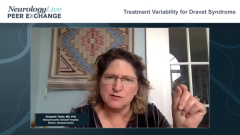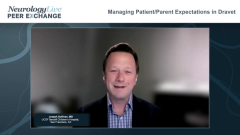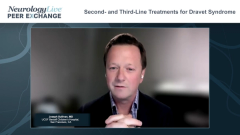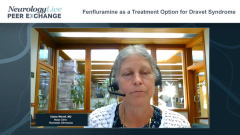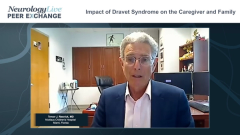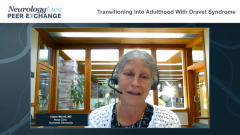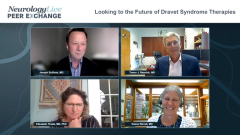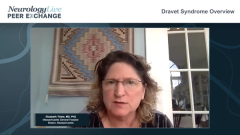
Fenfluramine as a Treatment Option for Dravet Syndrome
Elaine Wirrell, MD, provides background on fenfluramine, results from 2 clinical trials, and compares it to other treatment therapies.
Episodes in this series

Joseph Sullivan, MD: Elizabeth had made a comment on having some patients on both, referring to fenfluramine. Elaine, going in the order of how these medications went into clinical trials and gained FDA approval, could you also walk us through the data supporting fenfluramine’s efficacy and your personal experience with it?
Elaine Wirrell, MD: Sure. Fenfluramine is a serotonergic agent, but it also a positive modulator of the sigma-1 receptor. I’m not sure anybody exactly knows how that translates into improved seizure control, but it’s a novel mechanism. It’s an interesting story. Fenfluramine had been used by the group in Belgium for quite some time. It was actually initially used before we even realized that Dravet syndrome was Dravet syndrome and was associated with SCN1A pathogenic variants. When they looked at their data of patients who were treated many years ago, dating to the early 1990s, they saw that the kids who were treated and responded were kids who ultimately were found to have Dravet syndrome and that SCN1A pathogenic variant. I find that really cool.
There was actually a royal decree made by the king of Belgium so could continue to use this very effective medication. This led to the clinical trials. There were 2 main publications. The first was a trial of kids with Dravet syndrome who were not on stiripentol but were on other cotherapies. They looked at higher-dose fenfluramine, which was 0.7 mg/kg per day, compared with lower-dose 0.2 mg/kg per day, compared with placebo. They found there were significantly better outcomes in kids who were treated with fenfluramine and that the higher dose worked better. They saw a 50% reduction in seizures and a 70% reduction on the higher dose. It was a 41% reduction on the lower dose and about 7% on placebo.
The other cool thing from that study is they looked at those with much more significant response. They looked at patients with a 75% reduction in seizures. They found that nearly half of patients in the high-dose group had a greater than 75% reduction in seizures and about a quarter of patients were near seizure-free. That was very exciting. A second study was done that included kids who were on stiripentol. Fenfluramine was added to stiripentol and, because of the pharmacokinetic interaction between stiripentol and fenfluramine, they just compared 1 dose of fenfluramine that was essentially equal to the higher dose that was used in the first study. They found significant benefits. Those who were in the fenfluramine group had a 53% reduction in seizures compared with those who were treated with placebo, who had just a 7% reduction.
Joseph Sullivan, MD: We all get into these percentages and responder rates. Can you put that in context? For neurologists who are watching, we’re used to hearing about the 50% responder rate. These aren’t comparative head-to-head trials, but if we look at the value of a specific patient population, are all phenotype seizures are being counted in the same way? I pitch it to my families by providing the data from multiple sides. Can you put that into perspective for us comparing it with some of the other treatments?
Elaine Wirrell, MD: Yes. This 1 was certainly better than any of the version 1.0 treatment guidelines. This was better than any of our first-line therapies that we had suggested there. For me, what’s really intriguing is the proportion of patients who have a much more significant benefit. Patients had to have at least 1 seizure per week to get into the trial. Over 3 months, a quarter of the patients had between 0 and 1 seizures. Many of those patients were able to go a much longer time without any breakthrough seizures. That improves quality of life if you can get that to happen.
Joseph Sullivan, MD: I couldn’t agree more that these responder rates, 75% reduction, are something that we don’t often see in epilepsy drug trials, certainly in a patient population that’s so treatment resistant. To have any percentage of them that are near seizure-free is unprecedented. Elizabeth, can you comment on the idea of this being a syndrome diagnosis and beyond seizures? In your experience, I’m sure you’re seeing that in some of your patients. What is that translating into for the everyday lives of these patients?
Elizabeth Thiele, MD, PhD: When those trial results were released, we were all pretty impressed and very excited. It paralleled the efficacy seen in the Belgium experience, suggesting that this is going to be a very important drug in the management of seizures in Dravet syndrome. If I had a child with Dravet, a 70% reduction in seizures would be life transforming. I hear that from some of our kids who’ve responded beautifully to it—CBD [cannabidiol], or other treatments, really changes their life. The ability to leave the room and not worry that your child will have a bad seizure is freeing in many ways. It also buys the child a little more independence. A 70% reduction is still not what would be ideal seizure control, but it’s better than we’ve been able to do before with many of these patients. I’m really excited about the possible role of CBD, fenfluramine, and stiripentol in the treatment of these kids. We have many better options now than we did 5 years ago.
Joseph Sullivan, MD: I agree. And not only as we’ve all spoken about efficacy and tolerability—there are adverse-effect profiles for any medication—but it seems that fenfluramine and cannabidiol have very attractive adverse-effect profiles. Further expanding on that with fenfluramine, included in the studies was this measure of executive function, mainly to see if this drug had a negative impact in executive function. It was included as a safety measure. Then looking at some of the results of those surveys, in patients who had the 75% reduction in seizures, about 25% to 30% of them had clinically meaningful improvements in their behavior and executive function. Is that only seizures? Is it something about the medication? The jury is still out on that, but it highlights that more seizure control is often better, as long as it doesn’t come at the expense of moderate or severe treatment-related adverse effects.
I’m sure that this happens in your practices too. You’re talking about a new treatment and the family says, “Yes, but we’ve been there. We always get the drug, and it works great for the first couple of months and there’s the honeymoon effect. I don’t know if my emotions can tolerate another honeymoon effect.” For a lot of these drugs, we now have some longer-term open-label data. Trevor, would you mind commenting on what we’ve seen with fenfluramine and its longer-term use?
Trevor J. Resnick, MD: That question is brought up by every patient . The open-label extension demonstrated the 3 or 4 things we really want to see. One is that the effect is sustained. Another is you don’t have any new tolerability issues you didn’t get when you had a relatively shorter maintenance period. Third, the gorilla in the room for fenfluramine was the question of valvular heart disease. It demonstrated no red flags in the open-label extension study in more patients over a longer period of time. It’s very important in terms of real-world experience after having a control study showing that everything we’re seeing in the cannabidiol study was substantiated and validated with a robust seizure response. It’s a very valuable addition to our armamentarium.
Joseph Sullivan, MD: Absolutely. We’re looking at a group study that’s not immune to the honeymoon effect, but it’s comforting to see from those data that there does appear to be a durability of response. As we said with cannabidiol, it’s safe and appears to be well tolerated. Right now, fenfluramine does have an indication for treatment of seizures associated with Dravet syndrome in ages 2 and older. Maybe we’ll comment on this in our 2.0 guidelines. We’re all excited to see what impact these more syndrome-specific treatments can have if we have earlier diagnosis and earlier syndrome-specific treatment.
Elizabeth Thiele, MD, PhD: You have to pause and think how wicked exciting this has been for the Dravet community within the past 5 years. Suddenly we have 3 FDA-approved medications for a disorder where there were no FDA-approved specific treatments. That doesn’t happen very often, so it’s incredibly exciting.
Joseph Sullivan, MD: That coupled with our ability to do genetic testing and make an earlier diagnosis. I think back to fellowship. I saw 1 kid with Dravet syndrome, which means I missed a lot. The 1 we saw turned into a grand rounds type of thing. Fast-forward 15 years, and to your point, there are 3 FDA-approved medications and the ability to make a new diagnosis.
Thank you for watching this NeurologyLive® Peer Exchange. If you enjoyed the content, please subscribe to our e-newsletters to receive upcoming Peer Exchanges and other great content right in your inbox.
Transcript Edited for Clarity
Newsletter
Keep your finger on the pulse of neurology—subscribe to NeurologyLive for expert interviews, new data, and breakthrough treatment updates.


